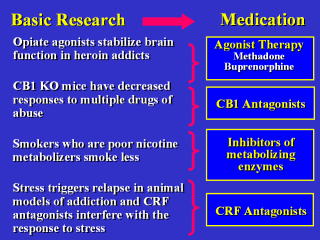Search inside of Supercourse and lectures in HTML and PPT format
 |
 |
front |1 |2 |3 |4 |5 |6 |7 |8 |9 |10 |11 |12 |13 |14 |15 |16 |17 |18 |19 |20 |21 |22 |23 |24 |25 |26 |27 |28 |29 |30 |31 |32 |33 |34 |35 |36 |37 |38 |39 |40 |review |
 Basic research has led to the identification of several potential medications for drug addiction. In addition to already approved medications for treatment of opiate addiction (e.g., methadone, buprenorphine), new approaches that target different aspects of addiction are also being developed. For example, the cannabinoid receptor system (CB1) is one that is being targeted for medications that reduce not only nicotine, alcohol and other drug addictions, but obesity as well. Drug metabolism can also be a factor in addiction susceptibility by altering the pharmacokinetics and reinforcing effects of drugs. Smokers who are poor metabolizers of nicotine smoke less and may be less vulnerable to addiction--medications may be developed to take advantage of that quality. Finally, animal models of relapse have allowed testing of medications that inhibit triggers of drug seeking, including stress. Corticotropin releasing factor (CRF) antagonists are examples as they inhibit the stress response and the resultant drug seeking behavior. |